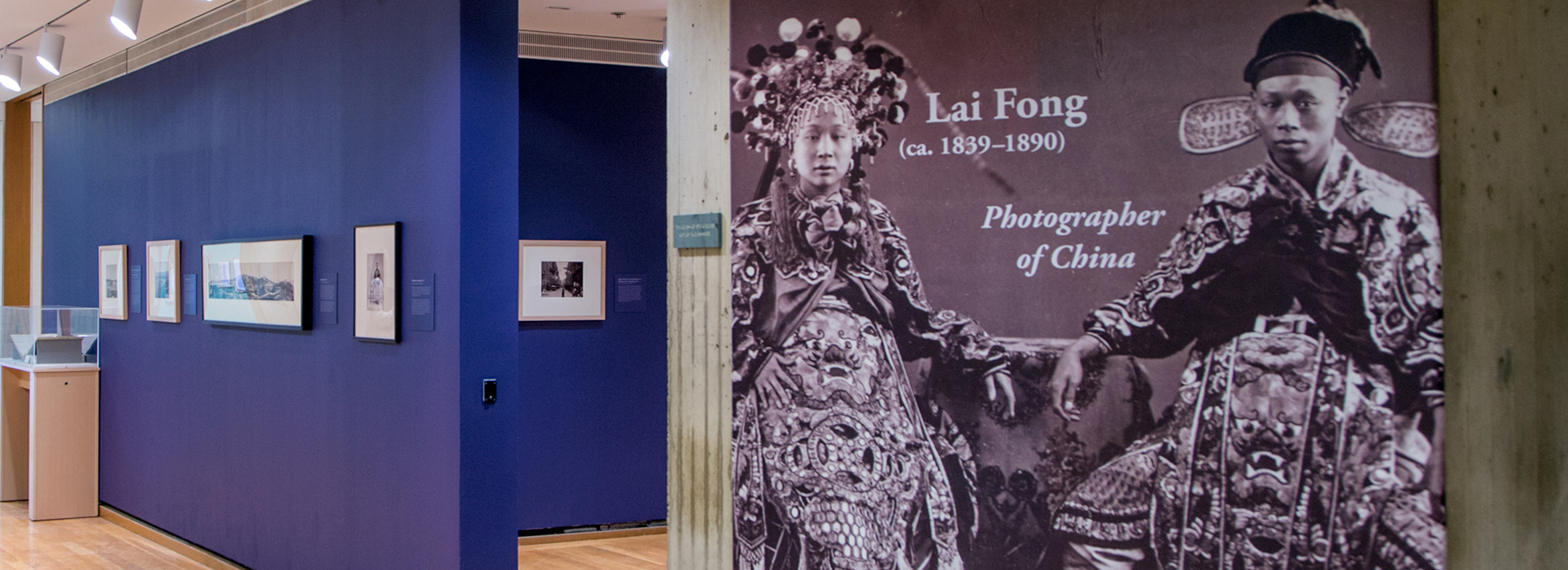
This exhibition was originally scheduled to be on view through June 14, 2020, but closed early on Sunday, March 15, 2020, due to the Covid-19 pandemic.
In the Moak, Schaenen, and Class of 1953 Galleries, Floor 2L
Lai Fong was arguably the most ambitious and successful photographer of nineteenth-century China. He began practicing under the name Afong in Hong Kong in the 1860s, and over the next twenty years built a towering reputation on his illustrious clientele, his impressive product range, and a catalogue of views of China “larger, choicer, and more complete…than any other in the Empire,” according to his advertisements. His photographs of Chinese cities, monuments, people, and land—however shaped by the desires of his cosmopolitan clientele—stand as records of places that have changed often beyond recognition, and of his own artistry, exuberance, and entrepreneurial brilliance.
Lai was born in Gaoming, Guangdong. His life would span one of the most convulsive periods in Chinese history. He arrived in Hong Kong in the 1850s, one of thirty million refugees of the Taiping Rebellion. Hong Kong was then a British colony, ceded following a string of Western aggressions intended to force increased access to the lucrative Chinese market. Over the next half century, internal upheavals and foreign encroachments wrought the end of more than two thousand years of imperial governance. Like the celebrated Western photographers Felice Beato and John Thomson, Lai photographed a changing world, but with an insider’s sensibility and understanding of the stakes inherent in these transformations.
The divergences between China as it had been and China as it was becoming thread through Lai’s oeuvre. Proposing this as a key strand in his work, this exhibition arranges its material—images of sacred landscapes and tram tracks, scholars and middlemen, examination halls and horse races—around the themes of the past, the new nineteenth-century present, and the international trade that provoked the transition from one to the other. This approach privileges the experiences and vision of the photographer.
Lai Fong (ca. 1839–1890): Photographer of China draws primarily from the collection of Stephan Loewentheil, JD ’75, who over three decades has assembled one of the world’s foremost collections of early photographs of China and supported the research necessary for their attribution. We are grateful for his support of this endeavor, and express our thanks to the Cornell Library’s Division of Rare and Manuscript Collections, the Metropolitan Museum of Art, and the Getty Research Institute for lending photographs from their collections.
An album of ninety-five photographs of Beijing has been in the collection of the Cornell Library since 1940. In 2019, the photographs were attributed to Lai by Kate Addleman-Frankel, the Gary and Ellen Davis Curator of Photography at the Johnson Museum, as part of ongoing research on the university’s collections of Asian photographs. The album is a remarkable compendium, the most complete collection of Lai’s images of the Chinese capital yet discovered. At least nineteen of them may have been entirely unknown previously; they do not appear in the only catalogue of Lai’s photographs reconstructed to date, by the historian Terry Bennett.
A concurrent exhibition, Lai Fong and Thomas Child: Photographs of Late Qing Dynasty Chinese Street Life, was also on view at Cornell’s Carl A. Kroch Library.
The Annual Stoikov Lecture on Asian Art, Who Is Lai Fong? New Perspectives on 19th-Century Photography in China, was presented on October 15, 2020, by Dr. Daisy Wang, with additional presentations by Kate Addleman-Frankel, Stacey Lambrow, and Yuhua Ding, PhD 2020, former curatorial assistant for Asian art at the Johnson. Watch the online presentation here.
This exhibition was curated by Kate Addleman-Frankel, the Gary and Ellen Davis Curator of Photography at the Johnson, and Stacey Lambrow, curator of the Loewentheil Photography of China Collection, with the assistance of Yuhua Ding, curatorial assistant for Asian art at the Johnson. It is supported in part by the Helen and Robert J. Appel Exhibition Endowment.








